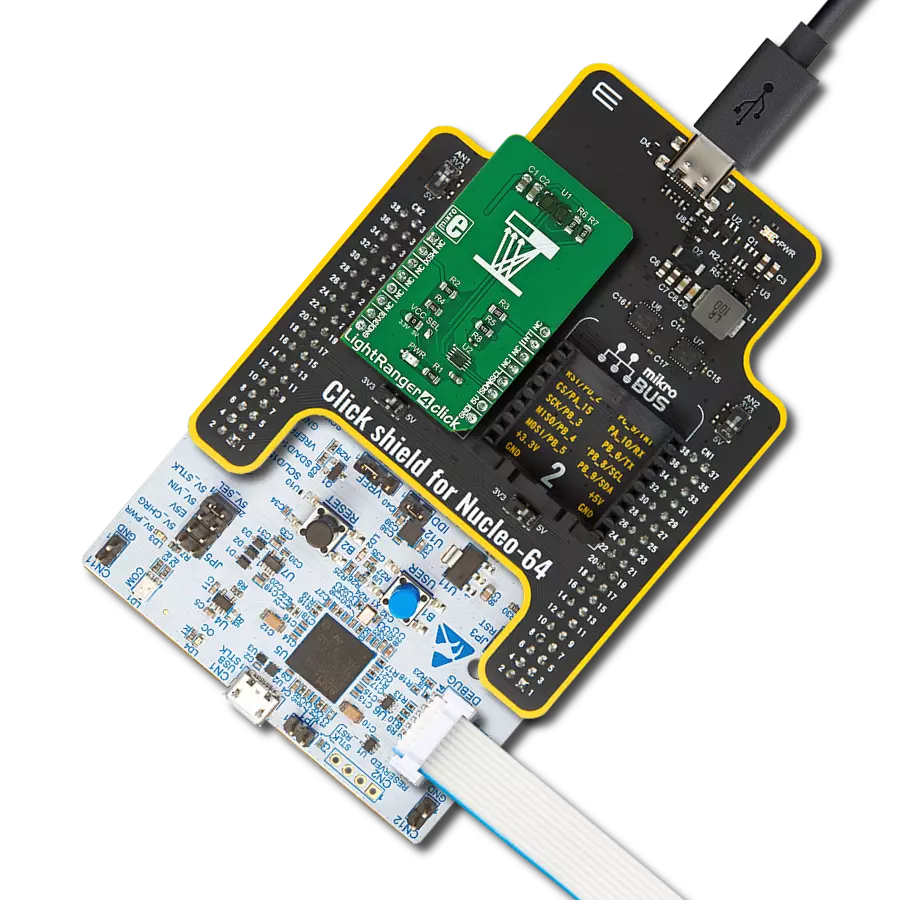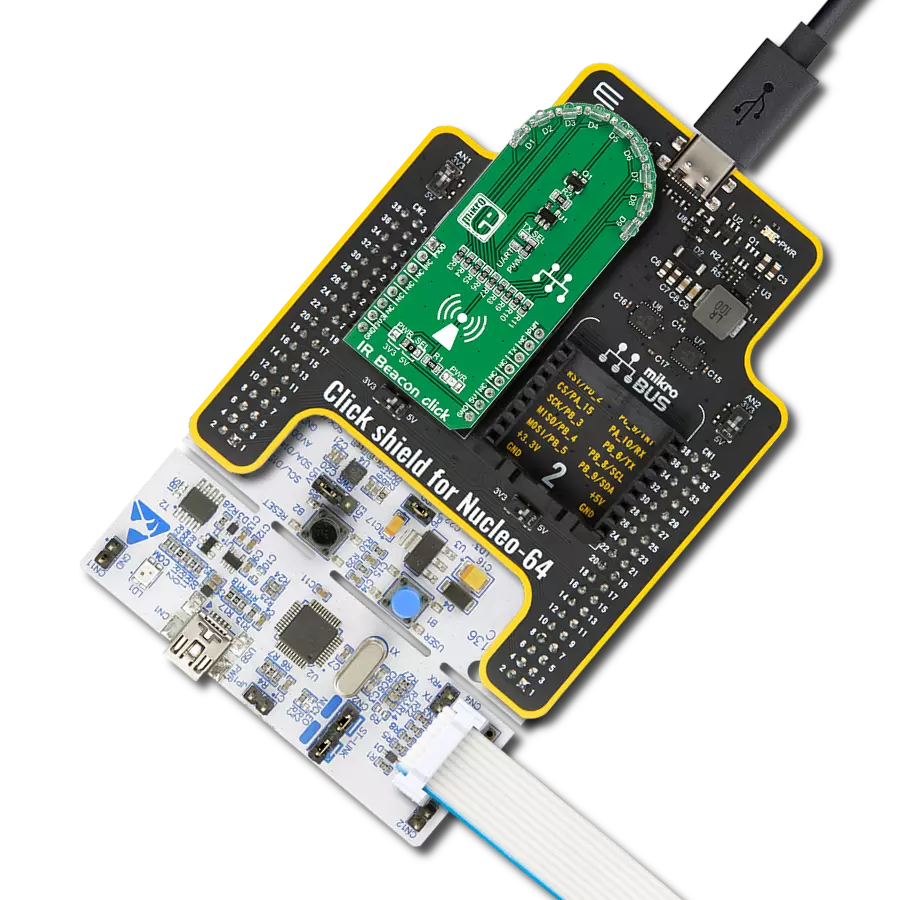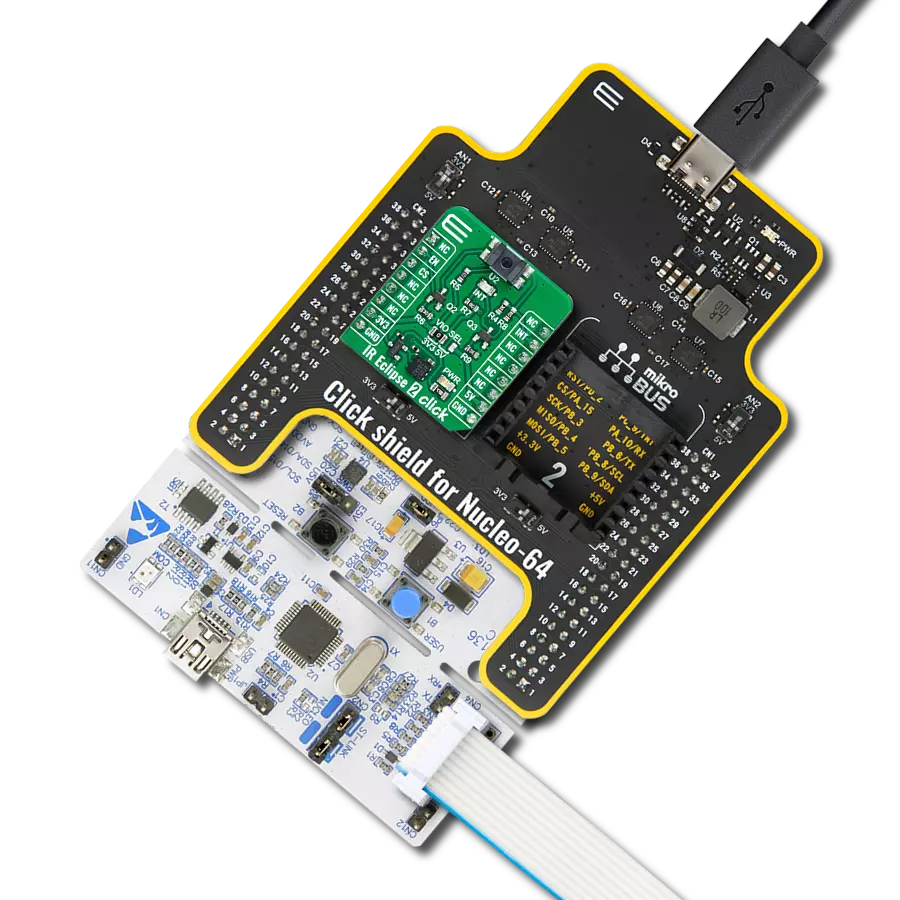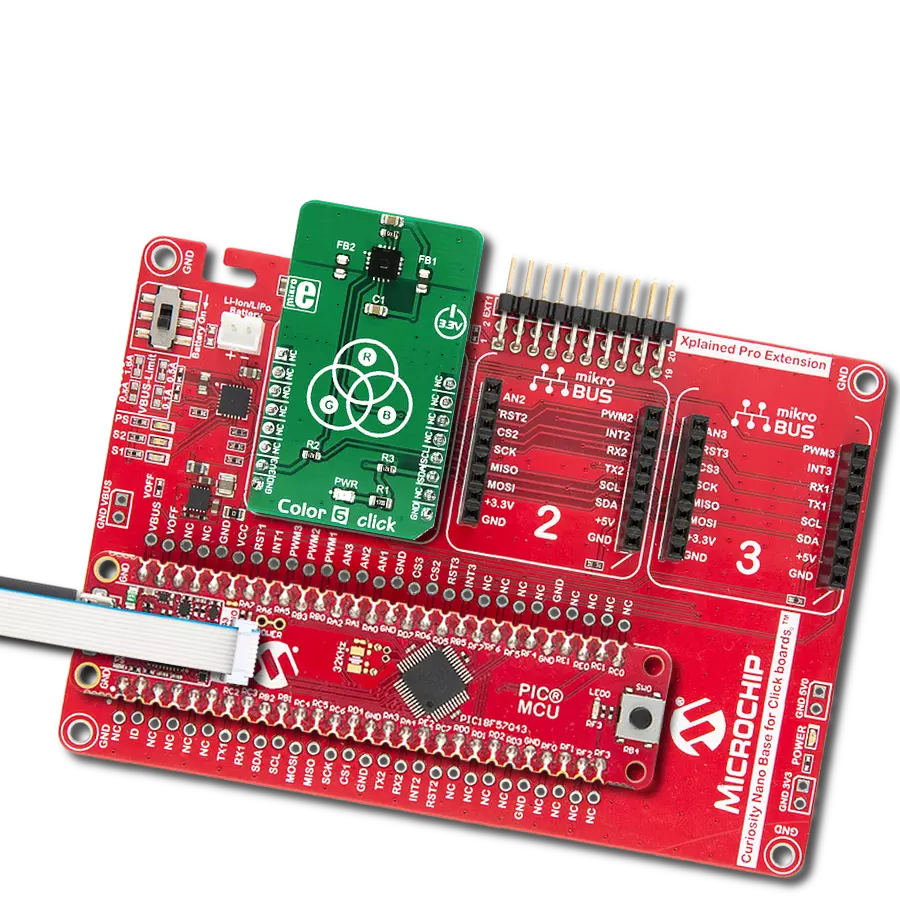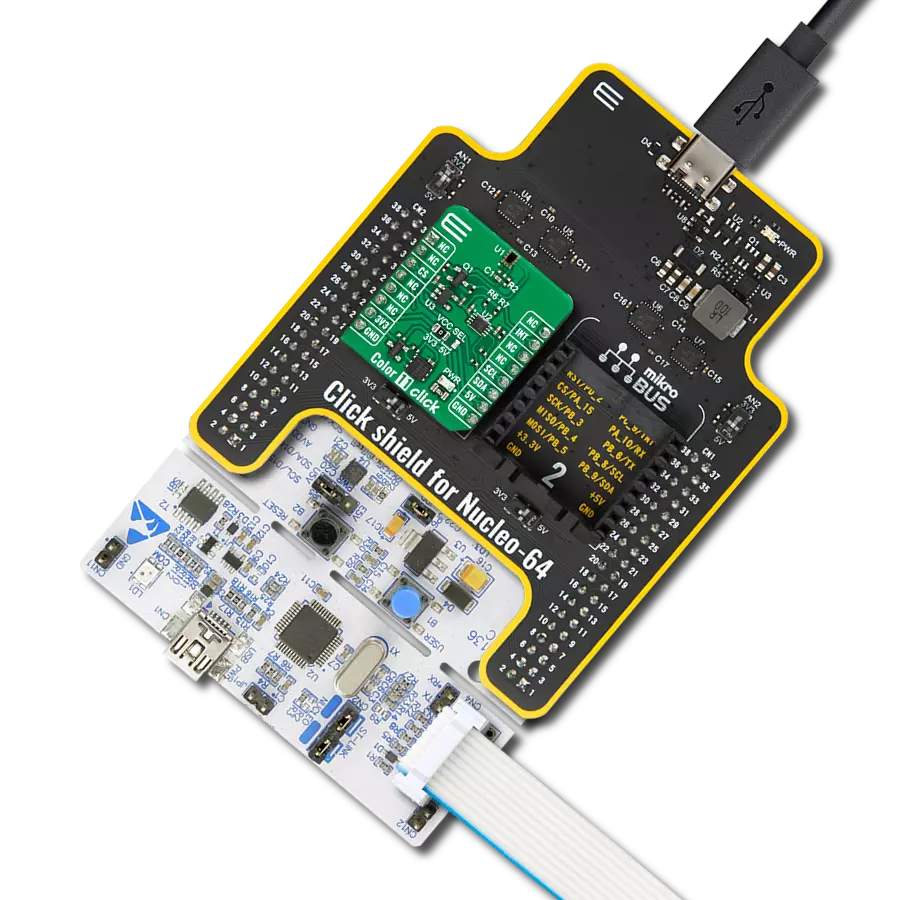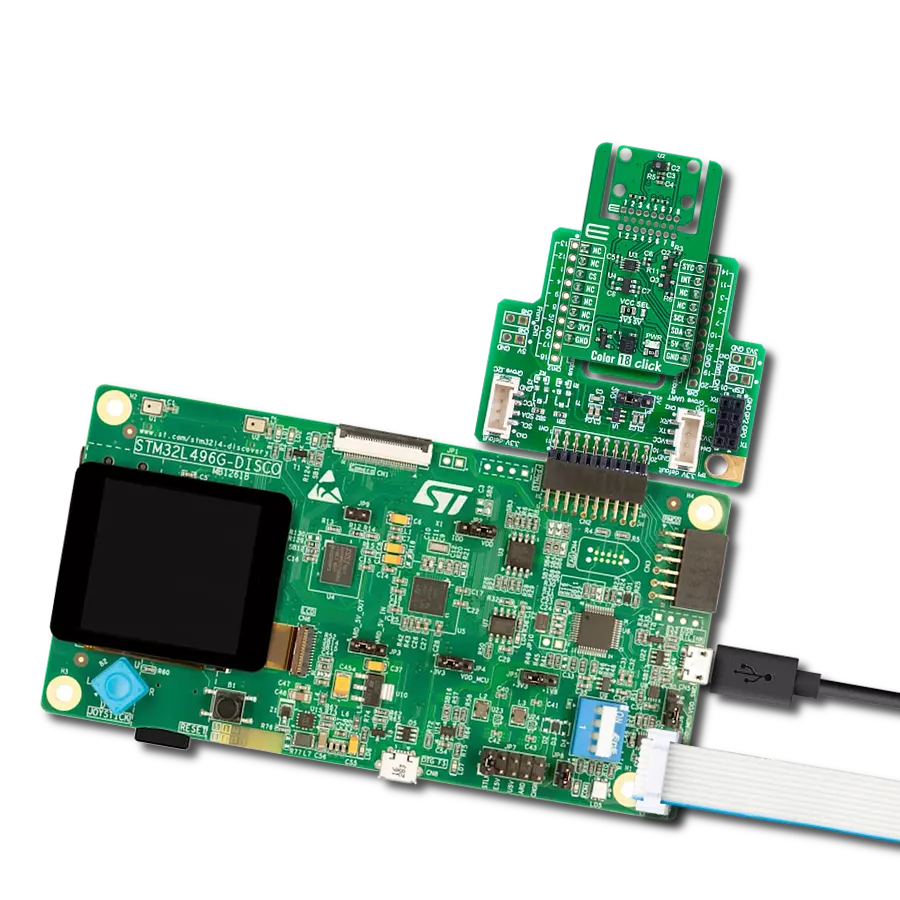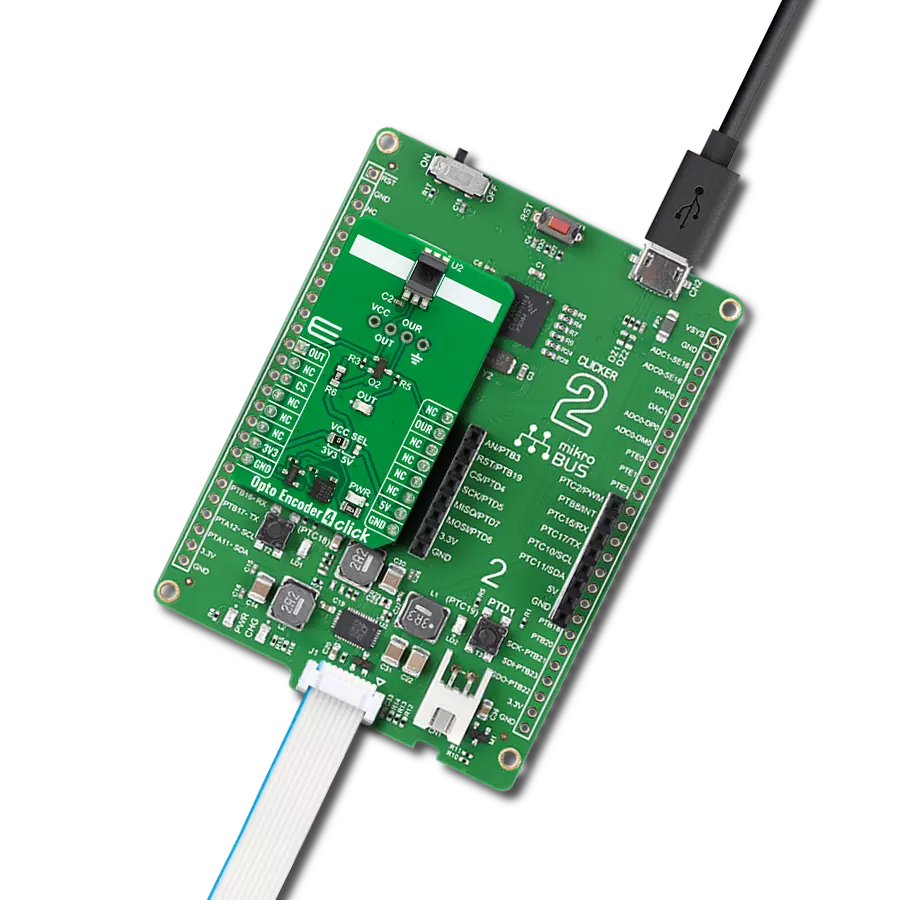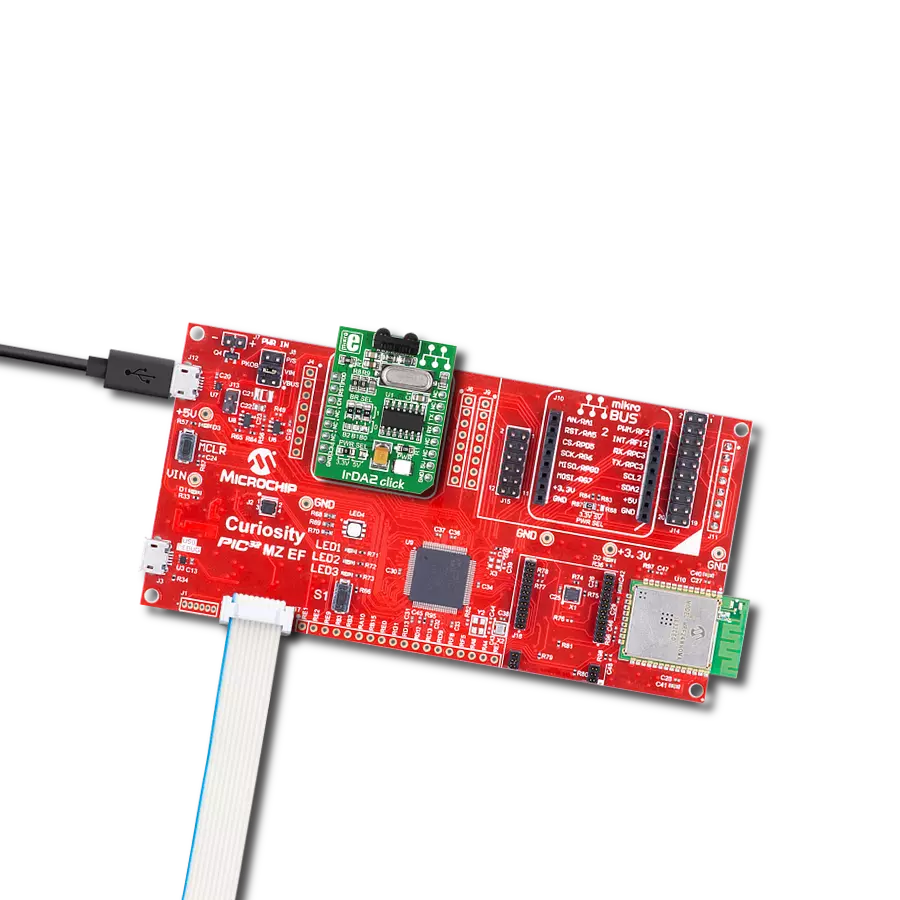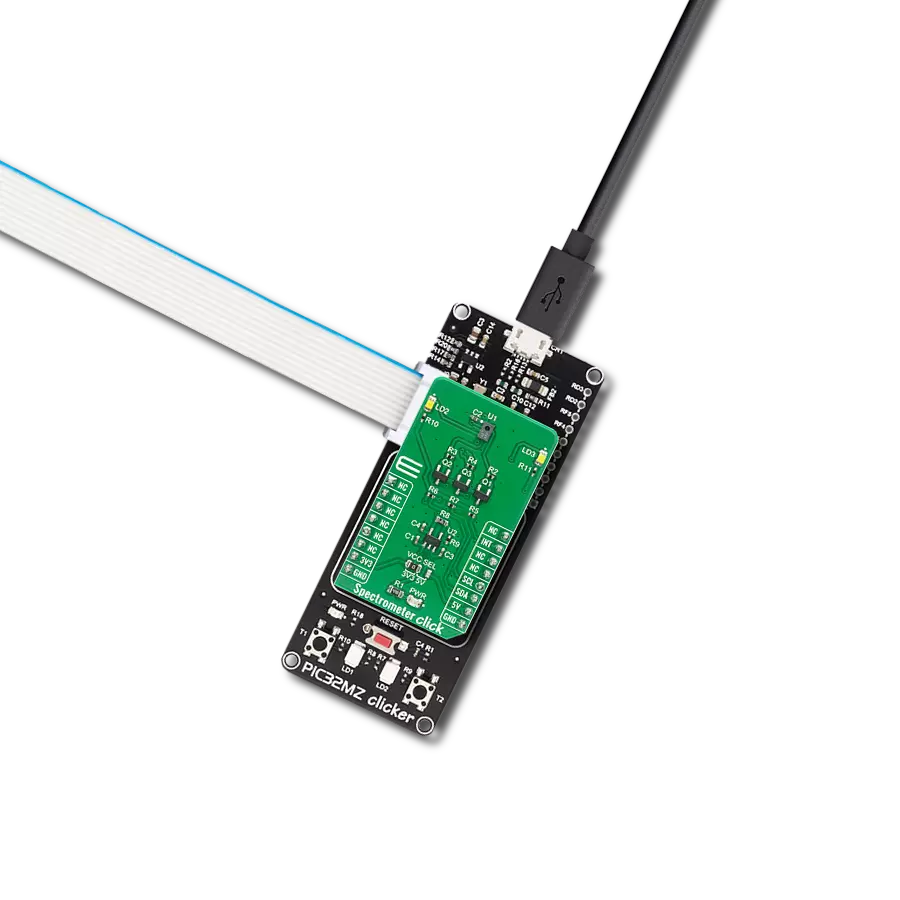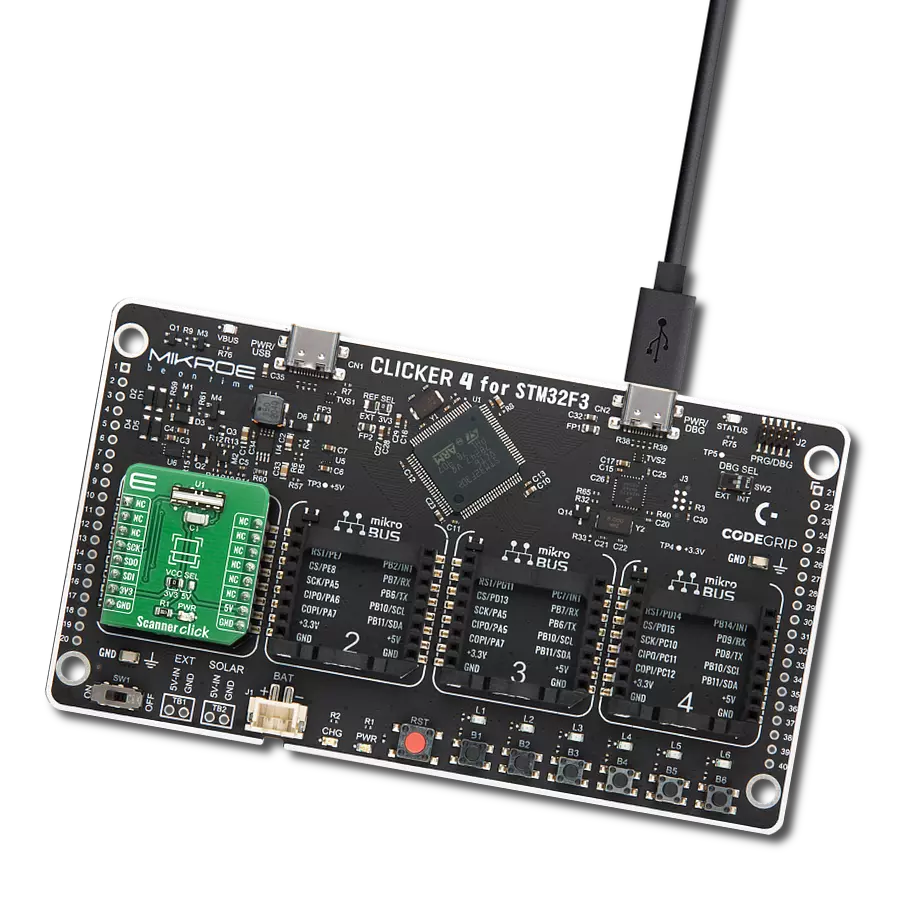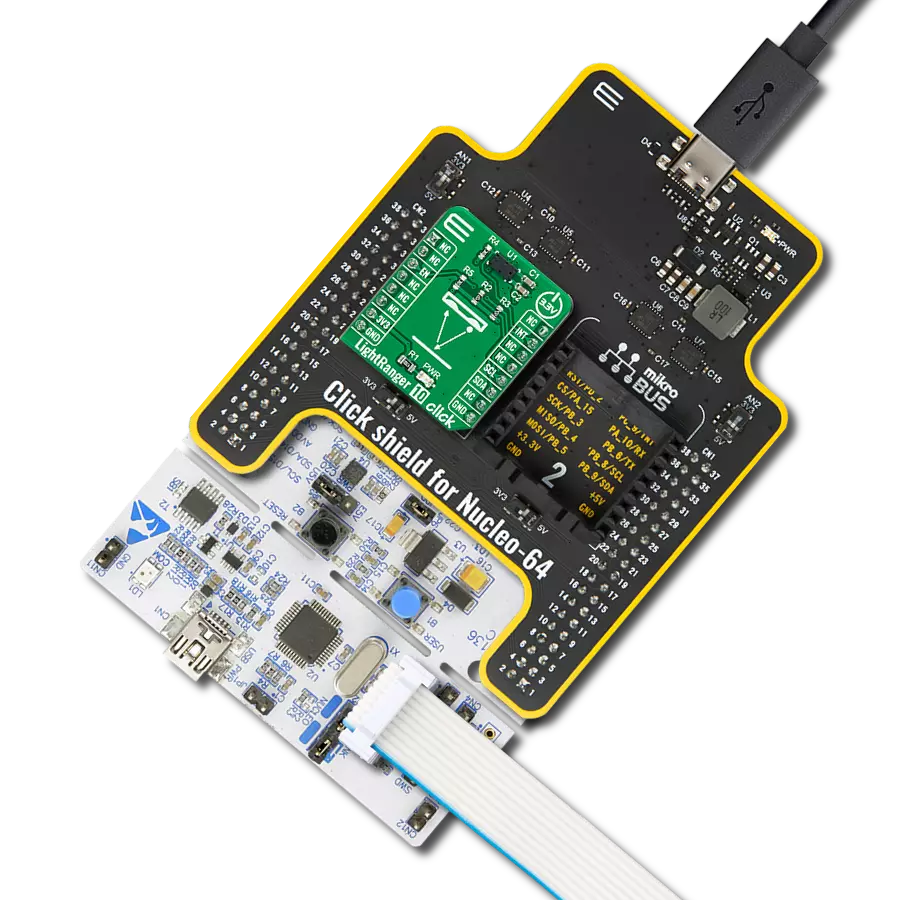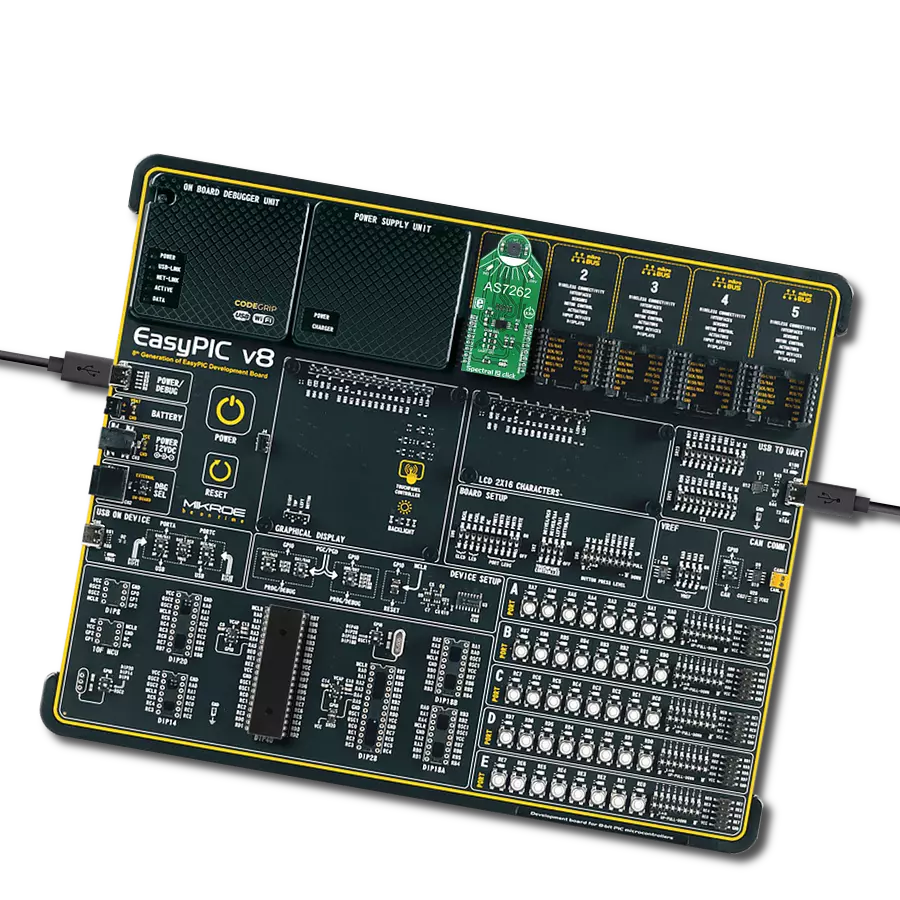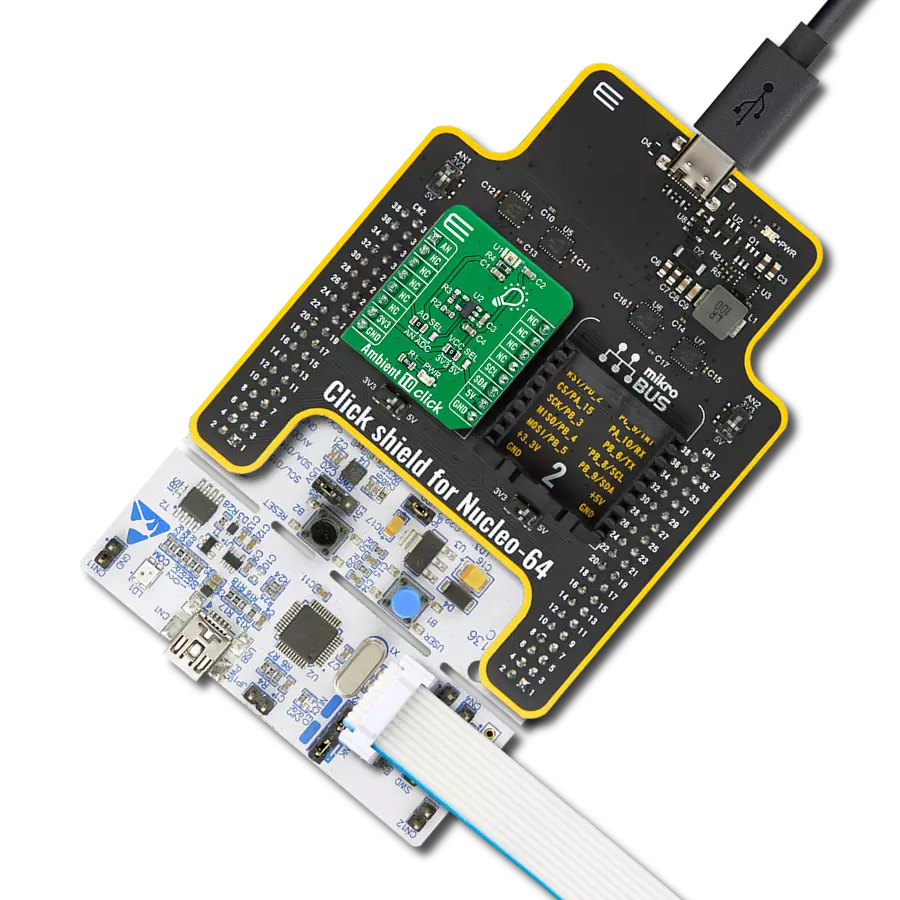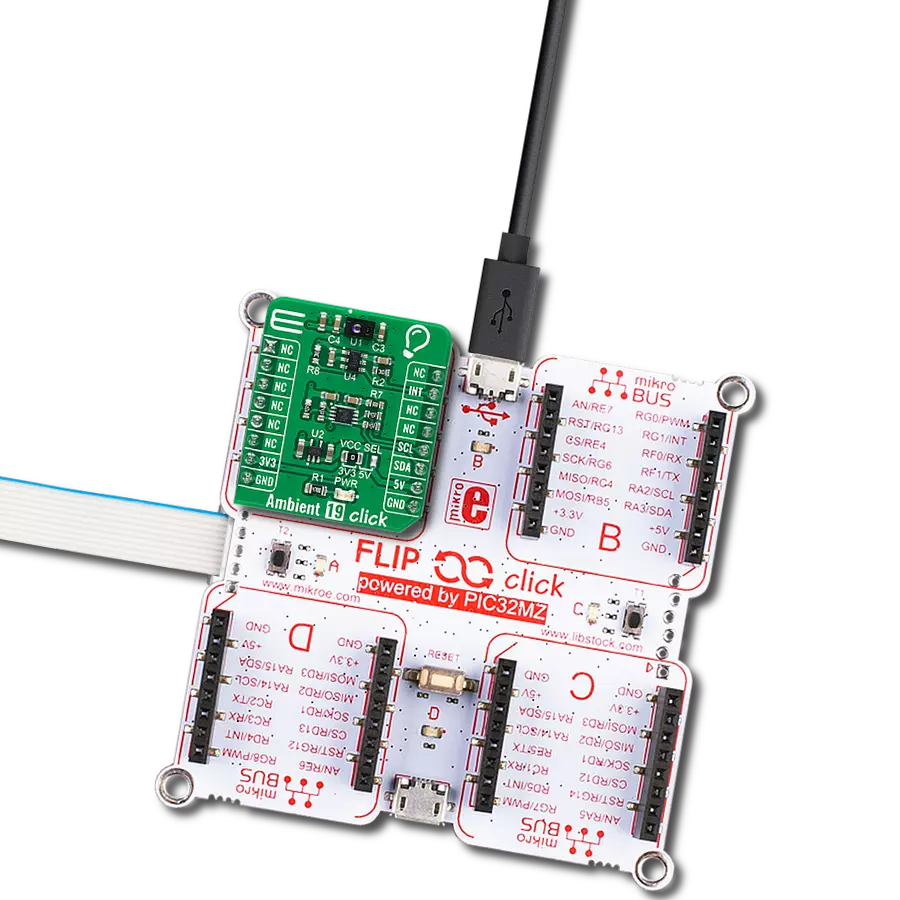Improve efficiency and accuracy in color-related tasks, from design and manufacturing to diagnostics and beyond.
A
A
Hardware Overview
How does it work?
Color 4 Click is based on the VEML6040, an advanced RGB/ambient light sensor from Vishay Semiconductors that provides fast and accurate spectral measurements. It is based on the Filtron™ technology, achieving the closest ambient light spectral sensitivity to real-human eye responses. The VEML6040 senses red, green, blue, and white light and processes those signals using a CMOS signal conditioning circuit. This digital RGBW information can be used in feedback control systems, among other things, to monitor and actively control a light source. This Click board™ detects light intensity under multiple lighting
conditions and through different attenuation materials, including dark glass. The VEML6040 provides a selectable measurement range from 515.4lx up to 16.496lx with the highest sensitivity of 0.007865lx/step. Its peak sensitivities for red, green, and blue are 645nm, 575nm, and 460nm, respectively. Moreover, it provides excellent temperature compensation, keeping the output stable under changing temperatures. Color 4 Click communicates with MCU using the standard I2C 2-Wire interface to read data and configure settings, supporting Standard Mode operation with a clock frequency of 100kHz and Fast Mode
up to 400kHz. The VEML6040 contains one configuration register (00h) for operation control and parameter setup. Its measurement results are stored in four separate registers, each for red, green, blue, and white, with addresses from 08h to 0Bh, respectively. All registers are 16-bit wide. This Click board™ can be operated only with a 3.3V logic voltage level. The board must perform appropriate logic voltage level conversion before using MCUs with different logic levels. Also, it comes equipped with a library containing functions and an example code that can be used as a reference for further development.
Features overview
Development board
Nucleo-64 with STM32F091RC MCU offers a cost-effective and adaptable platform for developers to explore new ideas and prototype their designs. This board harnesses the versatility of the STM32 microcontroller, enabling users to select the optimal balance of performance and power consumption for their projects. It accommodates the STM32 microcontroller in the LQFP64 package and includes essential components such as a user LED, which doubles as an ARDUINO® signal, alongside user and reset push-buttons, and a 32.768kHz crystal oscillator for precise timing operations. Designed with expansion and flexibility in mind, the Nucleo-64 board features an ARDUINO® Uno V3 expansion connector and ST morpho extension pin
headers, granting complete access to the STM32's I/Os for comprehensive project integration. Power supply options are adaptable, supporting ST-LINK USB VBUS or external power sources, ensuring adaptability in various development environments. The board also has an on-board ST-LINK debugger/programmer with USB re-enumeration capability, simplifying the programming and debugging process. Moreover, the board is designed to simplify advanced development with its external SMPS for efficient Vcore logic supply, support for USB Device full speed or USB SNK/UFP full speed, and built-in cryptographic features, enhancing both the power efficiency and security of projects. Additional connectivity is
provided through dedicated connectors for external SMPS experimentation, a USB connector for the ST-LINK, and a MIPI® debug connector, expanding the possibilities for hardware interfacing and experimentation. Developers will find extensive support through comprehensive free software libraries and examples, courtesy of the STM32Cube MCU Package. This, combined with compatibility with a wide array of Integrated Development Environments (IDEs), including IAR Embedded Workbench®, MDK-ARM, and STM32CubeIDE, ensures a smooth and efficient development experience, allowing users to fully leverage the capabilities of the Nucleo-64 board in their projects.
Microcontroller Overview
MCU Card / MCU
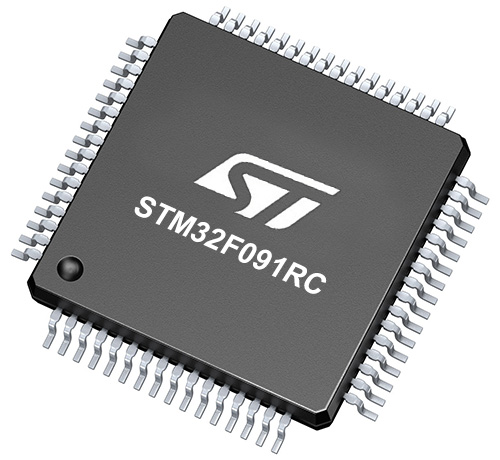
Architecture
ARM Cortex-M0
MCU Memory (KB)
256
Silicon Vendor
STMicroelectronics
Pin count
64
RAM (Bytes)
32768
You complete me!
Accessories
Click Shield for Nucleo-64 comes equipped with two proprietary mikroBUS™ sockets, allowing all the Click board™ devices to be interfaced with the STM32 Nucleo-64 board with no effort. This way, Mikroe allows its users to add any functionality from our ever-growing range of Click boards™, such as WiFi, GSM, GPS, Bluetooth, ZigBee, environmental sensors, LEDs, speech recognition, motor control, movement sensors, and many more. More than 1537 Click boards™, which can be stacked and integrated, are at your disposal. The STM32 Nucleo-64 boards are based on the microcontrollers in 64-pin packages, a 32-bit MCU with an ARM Cortex M4 processor operating at 84MHz, 512Kb Flash, and 96KB SRAM, divided into two regions where the top section represents the ST-Link/V2 debugger and programmer while the bottom section of the board is an actual development board. These boards are controlled and powered conveniently through a USB connection to program and efficiently debug the Nucleo-64 board out of the box, with an additional USB cable connected to the USB mini port on the board. Most of the STM32 microcontroller pins are brought to the IO pins on the left and right edge of the board, which are then connected to two existing mikroBUS™ sockets. This Click Shield also has several switches that perform functions such as selecting the logic levels of analog signals on mikroBUS™ sockets and selecting logic voltage levels of the mikroBUS™ sockets themselves. Besides, the user is offered the possibility of using any Click board™ with the help of existing bidirectional level-shifting voltage translators, regardless of whether the Click board™ operates at a 3.3V or 5V logic voltage level. Once you connect the STM32 Nucleo-64 board with our Click Shield for Nucleo-64, you can access hundreds of Click boards™, working with 3.3V or 5V logic voltage levels.
Used MCU Pins
mikroBUS™ mapper
Take a closer look
Click board™ Schematic

Step by step
Project assembly
Software Support
Library Description
This library contains API for Color 4 Click driver.
Key functions:
color4_set_config- Color 4 set configuration functioncolor4_get_color_data- Color 4 get color data functioncolor4_get_ambient_light- Color 4 get ambient light level function
Open Source
Code example
The complete application code and a ready-to-use project are available through the NECTO Studio Package Manager for direct installation in the NECTO Studio. The application code can also be found on the MIKROE GitHub account.
/*!
* @file main.c
* @brief Color 4 Click example
*
* # Description
* This library contains API for the Color 4 Click driver.
* This driver provides the functions for the sensor configuration
* and for reading RGBW and ambient light data from the device.
* This example displays RGBW data, Ambient light level, CCT data
* and the light color names.
*
* The demo application is composed of two sections :
*
* ## Application Init
* Initialization of I2C module and log UART.
* After driver initialization, default settings turn on the device.
*
* ## Application Task
* This example demonstrates the use of the Color 4 Click board™.
* Reads and displays the results of the RGBW, Ambient light level,
* calculate the correlated color temperature.
* This example also detects and displays the light color names.
* Results are being sent to the UART Terminal, where you can track their changes.
*
* @note
* Color detection is obtained based on the analysis
* of calculate the correlated color temperature (CCT) data
* and the CIE 1931 chromaticity diagram.
* For more details please refer to the “Designing the VEML6040 into an Application”
* application note (www.vishay.com/doc?84331).
*
* @author Nenad Filipovic
*
*/
#include "board.h"
#include "log.h"
#include "color4.h"
#define COLOR4_LIM_WHITE_COLOR 17000
#define COLOR4_LIM_DARK_LUX 15.0
#define COLOR4_CCT_LIM_BLUE_COLOR 9000
#define COLOR4_CCT_LIM_PURPLE_COLOR 7500
#define COLOR4_CCT_LIM_GREEN_COLOR 6000
#define COLOR4_CCT_LIM_YELLOW_COLOR 3500
#define COLOR4_CCT_LIM_ORANGE_COLOR 2200
#define COLOR4_CCT_LIM_PINK_COLOR 1900
#define COLOR4_CCT_LIM_RED_COLOR 700
static color4_t color4;
static log_t logger;
static uint16_t red_data, green_data, blue_data, white_data;
static float ambient_light, cct;
void display_color ( void )
{
if ( ambient_light < COLOR4_LIM_DARK_LUX )
{
log_printf( &logger, " Color DARK\r\n", cct );
}
else if ( white_data > COLOR4_LIM_WHITE_COLOR )
{
log_printf( &logger, " Color WHITE\r\n", cct );
}
else if ( cct > COLOR4_CCT_LIM_BLUE_COLOR )
{
log_printf( &logger, " Color BLUE\r\n", cct );
}
else if ( cct > COLOR4_CCT_LIM_PURPLE_COLOR )
{
log_printf( &logger, " Color PURPLE\r\n", cct );
}
else if ( cct > COLOR4_CCT_LIM_GREEN_COLOR )
{
log_printf( &logger, " Color GREEN\r\n", cct );
}
else if ( cct > COLOR4_CCT_LIM_YELLOW_COLOR )
{
log_printf( &logger, " Color YELLOW\r\n", cct );
}
else if ( cct > COLOR4_CCT_LIM_ORANGE_COLOR )
{
log_printf( &logger, " Color ORANGE\r\n", cct );
}
else if ( cct > COLOR4_CCT_LIM_PINK_COLOR )
{
log_printf( &logger, " Color PINK\r\n", cct );
}
else if ( cct > COLOR4_CCT_LIM_RED_COLOR )
{
log_printf( &logger, " Color RED\r\n", cct );
}
else
{
log_printf( &logger, " Color BLUE\r\n", cct );
}
}
void application_init ( void )
{
log_cfg_t log_cfg; /**< Logger config object. */
color4_cfg_t color4_cfg; /**< Click config object. */
/**
* Logger initialization.
* Default baud rate: 115200
* Default log level: LOG_LEVEL_DEBUG
* @note If USB_UART_RX and USB_UART_TX
* are defined as HAL_PIN_NC, you will
* need to define them manually for log to work.
* See @b LOG_MAP_USB_UART macro definition for detailed explanation.
*/
LOG_MAP_USB_UART( log_cfg );
log_init( &logger, &log_cfg );
log_info( &logger, " Application Init " );
// Click initialization.
color4_cfg_setup( &color4_cfg );
COLOR4_MAP_MIKROBUS( color4_cfg, MIKROBUS_1 );
if ( I2C_MASTER_ERROR == color4_init( &color4, &color4_cfg ) )
{
log_error( &logger, " Communication init." );
for ( ; ; );
}
if ( COLOR4_ERROR == color4_default_cfg ( &color4 ) )
{
log_error( &logger, " Default configuration." );
for ( ; ; );
}
log_info( &logger, " Application Task " );
log_printf( &logger, " ----------------------\r\n" );
Delay_ms ( 100 );
}
void application_task ( void )
{
if ( COLOR4_OK == color4_get_color_data( &color4, COLOR4_RED, &red_data ) )
{
log_printf( &logger, " Red: %u\r\n", red_data );
}
if ( COLOR4_OK == color4_get_color_data( &color4, COLOR4_GREEN, &green_data ) )
{
log_printf( &logger, " Green: %u\r\n", green_data );
}
if ( COLOR4_OK == color4_get_color_data( &color4, COLOR4_BLUE, &blue_data ) )
{
log_printf( &logger, " Blue: %u\r\n", blue_data );
}
if ( COLOR4_OK == color4_get_color_data( &color4, COLOR4_WHITE, &white_data ) )
{
log_printf( &logger, " White: %u\r\n", white_data );
}
log_printf( &logger, " - - - - - - - - - - - \r\n" );
if ( COLOR4_OK == color4_get_ambient_light( &color4, &ambient_light ) )
{
log_printf( &logger, " ALS lux level: %.2f\r\n", ambient_light );
}
if ( COLOR4_OK == color4_get_cct( &color4, &cct ) )
{
log_printf( &logger, " CCT: %.2f\r\n", cct );
}
log_printf( &logger, " - - - - - - - - - - - \r\n" );
display_color( );
log_printf( &logger, " ----------------------\r\n" );
Delay_ms ( 1000 );
}
int main ( void )
{
/* Do not remove this line or clock might not be set correctly. */
#ifdef PREINIT_SUPPORTED
preinit();
#endif
application_init( );
for ( ; ; )
{
application_task( );
}
return 0;
}
// ------------------------------------------------------------------------ END
Additional Support
Resources
Category:Optical



















